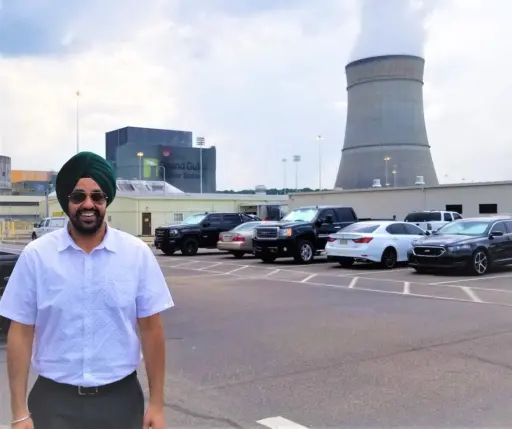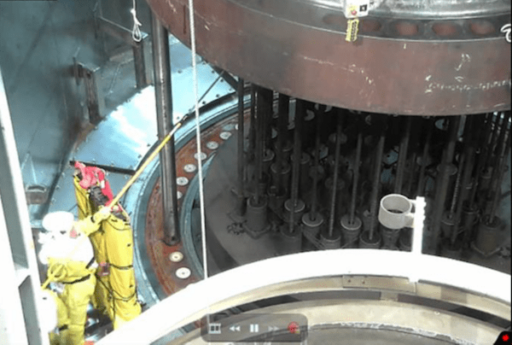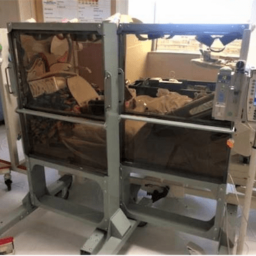Jayeesh Bakshi’s (NEEP MS ’14) graduate studies at the University of Wisconsin-Madison inspired him to develop a new type of transparent radiation shielding. And not only is his invention benefitting the nuclear industry, but it also is transforming treatment for neuroblastoma, a rare cancer that affects infants and young children.
Bakshi’s invention, ClearView Radiation Shielding, overcomes big drawbacks associated with conventional shields made of lead.
 Jayeesh Bakshi at the Grand Gulf Nuclear Station in Port Gibson, Mississippi.
Jayeesh Bakshi at the Grand Gulf Nuclear Station in Port Gibson, Mississippi.
As a chemical engineering undergrad at Thapar University in India, he first stepped foot in the nuclear industry through a six-month internship with the Atomic Energy Regulatory Board (AERB), the Indian equivalent of the Nuclear Regulatory Commission in the United States. The experience fueled his passion for nuclear, and he started applying to graduate programs for nuclear engineering.
Because of his interest in reactor safety, Bakshi’s colleagues at the AERB encouraged him to apply to the UW-Madison Department of Nuclear Engineering and Engineering Physics program, where Professor Michael Corradini was department chair at the time.
“Corradini is one of the top experts in the world for reactor safety,” Bakshi says. “He really carries a reputation.”
Although he was accepted to several graduate programs, Bakshi says choosing UW-Madison was an easy decision, given the department’s overall excellence and many renowned faculty.
At UW-Madison, he found an invigorating academic environment and inspiring faculty who were highly dedicated to his success. Courses taught by Professor Douglass Henderson, especially NE 408 on ionizing radiation and NE 555 on reactor dynamics, played a crucial role in his training as a nuclear engineer.
“My career is in radiation protection, and to be successful you need to understand how radiation works and how it interacts with matter and different materials,” Bakshi says. “Professor Henderson’s courses provided me with essential skills and knowledge in these areas.”
In addition, Bakshi says the opportunity to do hands-on work with the nuclear reactor on campus enhanced his educational experience. “Having access to the reactor allowed me to apply all the theory I’d been reading about and actually see the real results, which was incredibly valuable,” he says. “UW-Madison is one of very few programs in the country that have a working reactor, and it’s a phenomenal resource for educating students.”
 A reactor services fuel handler at the Braidwood Generating Station in Illinois works behind a shield wall with a ClearView Radiation Shielding window. Photo courtesy of Jayeesh Bakshi.
A reactor services fuel handler at the Braidwood Generating Station in Illinois works behind a shield wall with a ClearView Radiation Shielding window. Photo courtesy of Jayeesh Bakshi.
Presented with a career opportunity at Radium Inc., a Virginia-based company specializing in working in locked high radiation areas, Bakshi capitalized on his graduate training to take on an exciting challenge: Devise a better, safer alternative to conventional radiation shields made of lead.
“Lead does a good job for radiation protection, but it’s a nasty material; it’s toxic and not easy to deal with,” Bakshi says. “Nuclear power plants, hospitals and national labs spend significant amounts of money on treatment and disposal.”
At Radium, working closely with company president Cam Abernethy, Bakshi led the development of a transparent radiation shield that’s as effective as lead in attenuating radiation while being 50% lighter in weight. The patented ClearView Radiation Shielding is made of non-hazardous materials, allowing for simple disposal without any special treatment.
Since Radium’s shielding is completely see-through, it provides much greater visibility in high-radiation areas. Bakshi says that has enabled increased efficiency at nuclear power plants by making it much easier for workers to safely see what they’re doing as they complete important tasks, maintenance and inspections.
While developing the shielding, he conducted radiation attenuation testing at the Medical Radiation Research Center at UW-Madison, located in the medical physics department of the School of Medicine and Public Health. He says senior UWMRRC staff, including Wesley Culbertson, Cliff Hammer and John Micka, provided highly valuable guidance during the testing process. Through his interactions with UWMRRC staff, he learned that his new technology could potentially help improve treatment for pediatric patients with neuroblastoma.
 ClearView Radiation Shielding setup at the Mott Children’s Hospital at the University of Michigan, Ann Arbor, where the shields help improve treatment for pediatric patients with neuroblastoma. Photo courtesy of Jayeesh Bakshi.
ClearView Radiation Shielding setup at the Mott Children’s Hospital at the University of Michigan, Ann Arbor, where the shields help improve treatment for pediatric patients with neuroblastoma. Photo courtesy of Jayeesh Bakshi.
Because the treatment involves infusing patients with radioactive iodine 131, patients need to be kept in isolation, surrounded by opaque lead shielding, for an extended period of time. “The problem is that kids under 10 years old don’t want to be alone,” he says. “They’re already scared, so it can be challenging to successfully administer this treatment to young children.”
So Bakshi also developed a new rolling shield, allowing the transparent panels to be easily positioned against the child’s hospital bed. “So now the child can see the caregiver, it’s easy to communicate, and the child doesn’t feel alone—and that helps keep the patient calm, making it easier for hospital staff to manage the patient’s treatment.”
Bakshi has been working with hospitals that offer this specialized therapy, and he says the new shielding has been very well received.
And as he continues to work in the nuclear industry, Bakshi, who lives in Palo Alto, California, finds that his graduate degree from UW-Madison continues to pay off.
“When people ask me where I went to grad school and I say, ‘Wisconsin,’ they take me seriously as a highly skilled professional,” he says. “The reputation that the program carries is valuable.”